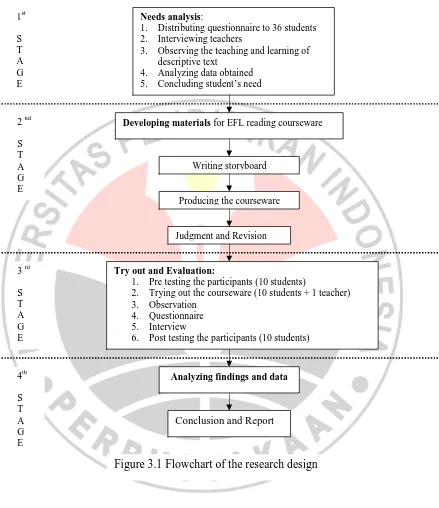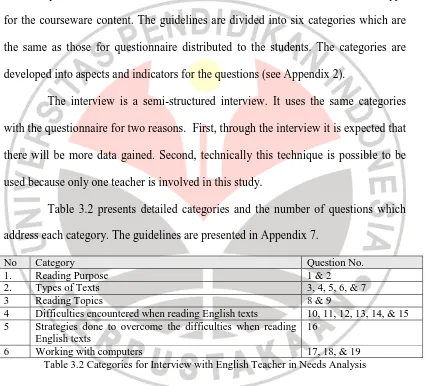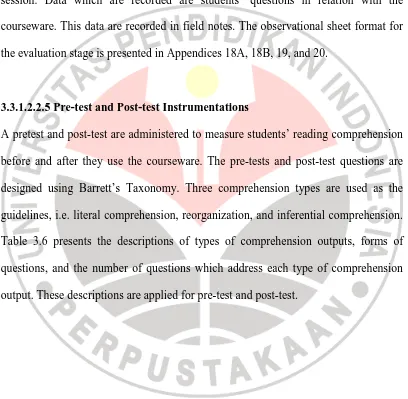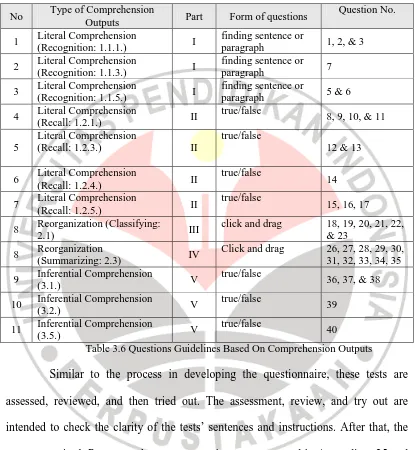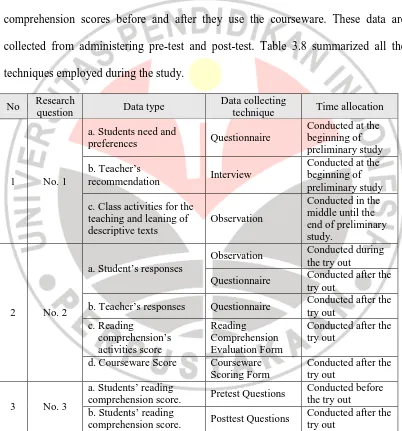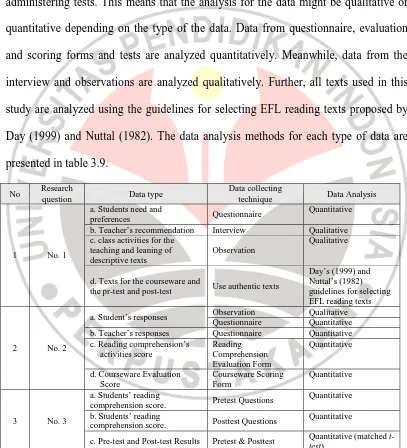TABLE OF CONTENTS
CHAPTER II DEVELOPING MATERIALS OF EFL READING COURSWARE FOR 8th GRADE STUDENTS
2.1 Principles in Material Development 8
2.4 Strategies in Teaching Descriptive Texts 32
2.5 Eight Grade Students 34
2.6 Presenting Reading Materials in Computer Based
Multimedia 35
2.6.1 Mayer’s Cognitive Theory of Multimedia Learning 37 2.6.2 Dickinson’s Specific Design Features for
Self-Instructional Materials 40
2.6.3 Plass’ Model of Interface Design 42
3.3.1.2.3 Summary of the
Instrumentations 59 3.3.1.2.4 Data Collection Technique 59
3.2.2 Data Analysis 61
3.4 Concluding Remarks 62
CHAPTER IV DATA ANALYSIS AND DISCUSSION
4.1 Data Analysis for The Courseware Development Stage 64
4.1.1 Need Analysis 64 4.2 Reading Courseware Production Process 92 4.2.1 Courseware Operational Model 92
4.2.2 Storyboard Development 101
4.2.3 Courseware Production 102
4.3 Courseware Try Out and Evaluation results Result 103 4.3.1 Students’ and Teacher’s Responses and
4.3.1.3 Observation 122 4.3.1.4 Important Findings from the Students’ and
Teacher’s Responses and Observation 126 4.3.2 Effectiveness of The Courseware 126 CHAPTER V CONCLUSION S AND RECOMMENDATIONS
5.1 Conclusions 129
5.2 Recommendations 130
BIBLIOGRAPHY 132
APPENDICES
Appendix 1: Aspects and Indicators of the Needs Analysis Questionnaires
Completed by Students 137
Appendix 2: Aspects and Indicators for the Interview with Teacher 139 Appendix 3: Aspects and Indicators of the Questionnaire for Evaluation
Completed by Students 142
Appendix 4: Aspects and Indicators of the Questionnaire for Evaluation
Completed by Teacher 144
Appendix 5: Questionnaire for Needs Analysis Completed by Students 148 Appendix 6: Result of Needs Analysis (Completed by Students) 152 Appendix 7: Interview Guidelines for the Needs Analysis 155 Appendix 8: Transcripts of Interview with the Teacher 157 Appendix 9: Observational Field Notes for Needs Analysis 162 Appendix 10: Questionnaire for Evaluation Completed by Students 169 Appendix 11: Result of Questionnaire for Evaluation (to obtain students’
responses towards the Courseware) 173
Appendix 12: Questionnaire for Evaluation Stage Completed by the
Teacher 176
Appendix 13: Result of Questionnaire for Evaluation Stage Completed by
the Teacher 180
Appendix 14: Evaluation Form for Reading Comprehension 184 Appendix 15: Result of Evaluation Form for Reading Comprehension 185
Appendix 16: Courseware Evaluation Form 186
Appendix 18B: Matrix 2 How the Students Complete Each Section of
the First Text the Students Accessed 189 Appendix 19: Matrix 3 The Frequency of Repeating the Repeatable
Section 190
Appendix 20: Observational Field Notes for Evaluation 191
Appendix 21: Comprehension Exercise for Text #1 192
Appendix 22: Comprehension Exercise for Text #2 197
Appendix 23: Comprehension Exercise for Text #3 201
Appendix 24: Reading Comprehension Test in the Courseware 205
Appendix 25: Pre-test Questions 209
Appendix 26: Post-test Questions 213
Appendix 27: Detailed Score of Pre-test and Post-test 217
Appendix 28: Storyboard 218
Appendix 29A: Examples of Courseware's Screen Presentation (Non
Activity Pages) 319
Appendix 29B: Examples of Courseware's Screen Presentation (Activity
Pages) 321
Appendix 30: The teacher's Source of Materials 324
Appendix 31A: Original Version of Text #1 343
Appendix 31B: Original Version of Text #2 345
Appendix 31C: Original Version of Text #3 347
Appendix 31D: Original Version of Text Used for the Test in the
Courseware 348
Appendix 31E: Original Version of Text Used for the Pre-test 349 Appendix 31F: Original Version of Text Used for the Post-test 350 Appendix 32: Documentary Photos of the Observation for Needs Analysis 352 Appendix 33: Documentary Photos of the Courseware Try Out 354 Appendix 34: Official Letter from the Indonesia University of Education to
the Principal of SMP Bale Endah Bandung. 356 Appendix 35: Official Letter from SMP Bale Endah Bandung 357 Appendix 36: The Ration Between Written and Spoken Texts in The
LIST OF TABLES
Table 2.1 Grid for Developing and Evaluating Reading Comprehension Questions
28 Table 3.1 Categories for Student Questionnaire in Needs Analysis 51 Table 3.2 Categories for Interview with English Teacher in Needs Analysis 52 Table 3.4 Categories for Student Questionnaire in Evaluation Stage 55 Table 3.5 Categories for Teacher Questionnaire in Evaluation Stage 55 Table 3.6 Questions Guidelines Based On Comprehension Outputs 58 Table 3.7 Research Instruments Based on Research Questions 59 Table 3.8 Data Collecting Technique Based on Research Questions and
Data Type
60 Table 3.9 Data Analysis Based on Data Type and Data Collecting
Technique
61 Table 4.1 Student’s grammatically-wrong sentences form the first writing tasks
77 Table 4.2 Students’ grammatically-wrong sentences from the second
writing task
79
Table 4.3 Summary of the observation results 79
Table 4.4 Summary of texts analysis 86
Table 4.5 Linguistic Elements of the selected texts 89 Table 4.6 The Sequence and Integration of Text and Tasks 90
Table 4.7 Pre-test and post-test results 127
Table 4.8 Paired sample statistics of the pre-test and post-test 127 Table 4.9 Paired sample correlation of the pre-test and post-test 127 Table 4.10 Paired sample test of the pre-test and post-test 128
Figure 2.1 Interactive Approach to Reading 13 Figure 2.2 Fry Graph for Estimating Reading Ages (grade level) 21 Figure 2.3 Fry Graph for Estimating Reading Ages (in years) 22
Figure 2.4 The Barrett Taxonomy 26
Figure 2.5 Idea Web 34
Figure 2.6 Mayer’s Cognitive Theory of Multimedia Learning 39
Figure 2.7 Gordon’s Screen Design Guidelines 43
Figure 2.8 Gordon’s Guidelines for The Use of Color 43
Figure 4.1 Program Operational Model 95
Figure 4.2 Second Level of Preview Section 96
Figure 4.3 Second Level of Choose Text Section 98
Figure 4.4 Second Level of Preview Section 100
CHAPTER I Introduction
This chapter introduces the present study. It presents the background, scope, purpose, research questions, significance, and keywords used.
1.1 Background of the Study
Teaching materials are crucial in most language classes because they generally become the basis for activities and practices in the classroom. They become the language input students receive, provide ideas for teachers on how to plan and teach lessons, and serve as formats that teachers can use (Richard, 2002:251). With regards to these essential roles of materials for both students and teachers, developing them becomes a crucial decision as well.
In preparing the reading texts and exercises for students a definition of reading needs to be selected. This definition becomes the basis for the development process. This present study believes that reading is a fluent process of readers combining information from a text and their own background knowledge to build meaning (Anderson in Nunan, 2003). In other words, it is believed that during reading reader processes, in his mind, new information from the text by integrating them with his background knowledge. This means that conceptual grounding for the selected reading topics is one of the considerations in developing the reading materials.
Reading materials may be presented through one type of medium such as paper or through a combination of several media better known as multimedia. One of the frequently used multimedia in the field of language learning is computer based multimedia which integrates various kinds of media like texts, voice, pictures, animation, and video clips in a single software (Jacobs, 1992 in Munir, 2001). It is believed that such media provide students with richer mental image to support their language learning (Frommer, 1998 in Hadley, 2001:163).
and address their individual interests. Meanwhile, the interactive learning results in the improvement of sensory stimulation (Hoogeven, 1995 in Munir 2001).
Computer based multimedia in education can function as courseware. Courseware is defined as software and data used in computer-based training (Encarta Dictionary Tools, 2006). Therefore, EFL Reading courseware is software designed to be used as a media in the teaching and learning of EFL reading. The teaching and learning are designed and packaged in computer-based multimedia software.
Considering the facts above, the present study focuses on developing materials for a prototype of an EFL reading courseware. The development was intended to increase student’s reading comprehension through written, visual, and auditory modes. The term ‘increase’ implies that the teaching of reading here refers to what Anderson (in Nunan 2003) called “teaching learners who already have reading skills in their first language”.
1.2 Scope of the Study
This study is part of a 3-year research program on The Development and Effectiveness of Multimedia in English Language Learning for Junior High Students conducted by Prof. Dr. Nenden Sri Lengkanawati, M.Pd, Dr. Iwa Lukmana, M.A. and Dr. Munir, MIT. In the first year the research dealt with mapping the condition of learning English in junior high schools and developing the prototype of instructional design and storyboard as the springboard to develop the multimedia software. In the second year the research focuses on developing materials for the software. In the last year the research will focus on measuring the effectiveness of the software in the teaching and learning process.
This study is under the second year period. Therefore, it concentrates on courseware materials development. More specifically, the materials are intended to increase 8th grade students’ reading skill.
1.3 Purpose of the Study
The focus of this study is to develop materials of an EFL reading courseware for 8th grade students. Within this context, the study attempts to
(1) describe the processes involved in developing EFL reading comprehension material courseware,
(2) find out students’ and teacher’s responses toward the material designed, and (3) compare students’ reading comprehension before and after using the
1.4 Research Questions
In line with the above-mentioned purposes, the problems of the present study are formulated in the following research questions.
(1) What are the processes involved in developing materials of EFL reading comprehension courseware?
(2) How do students and teacher respond to the courseware?
(3) Does the reading courseware improve students’ reading comprehension?
1.5 Significance of the Study
This study may be of benefit to students, English teachers, material developers and other researchers. Students may use the courseware individually at school or at home to increase their reading comprehension skill, particularly in terms of descriptive texts. When using the courseware students are trained to study independently, in their own pace. English teachers may use the courseware as supplementary materials in their classes. Material developers interested in integrating multimedia into the teaching and learning process may develop the courseware for other types of texts or other English language skills. Other researchers may use the courseware to conduct further research.
1.6 Research Methodology
observational sheets, (4) learning materials in the form of the prototype courseware, and (5) tests, which include pre-test and post-test. Findings from the questionnaires, interviews, and observational sheets are analyzed descriptively. Meanwhile, scores from the pre-test and post-test are analyzed using the matched t-test.
1.7 Definition of Key Terms
Several key terms are used in explaining, discussing, and reporting the results of this present study. There are four key words used, i.e. EFL reading courseware, multimedia, CD-ROM, interactivity, and descriptive text. Courseware is defined as software and data used in computer based training (Encarta Dictionary Tools, 2006). In this study EFL reading courseware refers to software which is used as supplementary material to increase the students’ reading skill through written, visual, and auditory modes.
information to the readers. In this study the text particularly refers to descriptive reading texts.
1.7 Concluding Remark
CHAPTER III Research Methodology
This chapter discusses the research methodology employed in the present study. The discussion starts from the research problems since it is the basis for the whole study. Based on the research problems the research was designed. The research design is followed by the description of research site and participants, research methods, research instruments, data collection technique, and methods of data analysis.
3.1 Research Problems
The focus of this study is to develop materials of an EFL reading courseware for 8th grade students. This leads to three research problems, i.e.
(1) What are the processes involved in developing materials of EFL reading comprehension courseware?
(2) How do students and teacher respond to the courseware designed? (3) Does the reading courseware improve students’ reading comprehension?
3.2 Research Design
The present study is divided into four stages, i.e. needs analysis, material development, try out and evaluation, and analysis of all collected data. The needs analysis is intended to obtain data on students’ needs and preference in relation to reading comprehension. This is done by distributing a questionnaire to the students, interviewing the teacher, and observing the class activities.
The second stage of the study is material development stage, including both the reading material and courseware. Research activities in this stage are developing reading materials, writing storyboard, producing, judging, and revising the courseware. The material development includes selecting texts, designing exercises and instructions, integrating texts and exercises based on taxonomy for reading comprehension, and designing mechanism for readers’ feedback. The storyboard contains complete description of lesson presentation using multimedia. Meanwhile, the software production was done by a software engineer. When the software is completed, it is judged by a multimedia and EFL methodology experts who are the researcher’s supervisors. Finally, the courseware is revised.
find students’ responses towards the courseware. Meanwhile, teacher is asked to give score for the courseware, complete a reading comprehension evaluation form, and complete a questionnaire. Finally, a posttest is administered.
The fourth stage of the study is the data analysis and report stage. Data from questionnaire, interview, observations, scoring forms, pretest, and posttest are analyzed. The result of the analysis is concluded and reported.
4th
1. Distributing questionnaire to 36 students 2. Interviewing teachers
3. Observing the teaching and learning of descriptive text
4. Analyzing data obtained 5. Concluding student’s need
Developing materials for EFL reading courseware
1st
1. Pre testing the participants (10 students)
2. Trying out the courseware (10 students + 1 teacher) 3. Observation
4. Questionnaire 5. Interview
6. Post testing the participants (10 students) Writing storyboard
3.3 Research Procedure
This section includes data collection and data analysis. Data collection is discussed in terms of the site and participants, the instrumentation, and the collection technique. Meanwhile, data analysis is discussed based on the type of data that would be obtained.
3.3.1 Data Collection
3.3.1.1Research Site and Participants
This study is conducted in one junior high school in Bandung because this school has a special program, i.e. acceleration class, and provides a compulsory subject, i.e. Skills for Computer Technology and Information, which requires the students to work in the computer laboratory. The acceleration class is a pilot project for the school and when the present study was conducted the students were in their eighth grade. This class consists of 36 students.
needs analysis and try out sessions. Students’ familiarity with working individually has made the courseware try out possible.
Meanwhile, the Skills for Computer Technology and Information subject becomes an important basis for the site selection because the subject has made the courseware try out possible. This particular subject implies that computer is not a new and extraordinary medium. Further, the school also provides the acceleration class with two units of computer capable of connecting to the Internet. This ensures the researcher that both the students and the teacher are familiar with working with the computer.
The participants in needs analysis stage are different from those in the evaluation stage. In the needs analysis all students (36 students) of the acceleration class are involved. However, the try out stage is conducted with only 10 students of the class. This is due to the limited number of computers available: only ten computers can be used for the implementation.
The selection of students who are involved in the trial session is done purposively (Alwasilah, 2003; McMillan and Schumacher, 2001; Maxwell, 1996). The researcher asked the teacher to select three students with high scores, four students with average scores, and three students with low scores in her English class. Referring students’ score records, including those when the students were in their seventh grade, the teacher select the students.
3.3.1.2Instrumentations
The present study involves two types of instrumentations, i.e. needs analysis instruments and courseware evaluation instruments. Needs analysis instruments include a questionnaire for students, an interview guideline to interview the teacher, and observational sheets to record the class activities. Courseware evaluation instruments consist of two questionnaire to be completed by ten students and a teacher, a reading comprehension evaluation and a courseware evaluation forms which are completed by the teacher, observational sheets to record students’ responses during the try out session, and pre-test and post-test questions.
3.3.1.2.1 Needs analysis Instrumentations
The instruments used to examine students’ needs in reading comprehension are questionnaire, interview and observation. Each of these instruments is described in Sections 3.2.2.1.1.1, 3.2.2.1.1.2, and 3.2.2.1.1.3.
3.3.1.2.1.1 Questionnaire
their familiarity with working with computer. This questionnaire is completed by students in the beginning of the first stage of the study.
This questionnaire is developed based on six categories of questions previously mentioned. Each category is developed into aspects and indicators for each question (see Appendix 1). The 23 questions used here are closed-type questions in which choices of alternatives are offered to the respondents. Table 3.1 presents the categories and the number of questions which address each category.
No Category Question No.
1. Reading Purpose 1. 2, 3, 4, 5
2. Types of Texts 6, 7, 8, 9
3 Reading Topics 10
4 Difficulties encountered when reading English texts 11, 12, 13, 14 5 Strategies done to overcome the difficulties when reading
English texts
15, 16, 17
6 Working with computers 18, 19, 20, 21, 22, 23
Table 3.1 Categories for Student Questionnaire in Needs Analysis
The responses are recorded in two ways: three categories of purposes which answer can be always, sometimes, or never, and two categories of purposes which answer can be yes or no.
3.3.1.2.1.2 Interview Guidelines
The second instrument for needs analysis is the interview guidelines. These guidelines are used to interview the teacher to gain data on students’ need from the teacher’s point of view and to obtain teacher’s recommendation in terms of text type for the courseware content. The guidelines are divided into six categories which are the same as those for questionnaire distributed to the students. The categories are developed into aspects and indicators for the questions (see Appendix 2).
The interview is a semi-structured interview. It uses the same categories with the questionnaire for two reasons. First, through the interview it is expected that there will be more data gained. Second, technically this technique is possible to be used because only one teacher is involved in this study.
Table 3.2 presents detailed categories and the number of questions which address each category. The guidelines are presented in Appendix 7.
No Category Question No.
1. Reading Purpose 1 & 2
2. Types of Texts 3, 4, 5, 6, & 7
3 Reading Topics 8 & 9
4 Difficulties encountered when reading English texts 10, 11, 12, 13, 14, & 15 5 Strategies done to overcome the difficulties when reading
English texts
16
6 Working with computers 17, 18, & 19
Table 3.2 Categories for Interview with English Teacher in Needs Analysis
3.3.1.2.1.3Observational Sheets
Consequently, the observations are addressed to both students and the English teacher. The data is used to determine the position of the courseware developed in the English class.
The observational data are recorded in two kinds of field notes. The first field note is used to record teacher’s techniques in teaching descriptive texts. The second field note is used to record the students’ participation during the class. The observational sheet format is presented in Appendix 9.
3.3.1.2.2 Instruments for Try Out and Evaluation
instructions and test for the courseware are presented in Appendices 21, 22, 23, and 24.
The instrumentations for evaluation include instrumentations for courseware evaluation and instrumentations for preliminary analysis of courseware effectiveness. The first instrumentations include questionnaire completed by students and teacher, reading comprehension and courseware evaluation forms completed by the teacher, and observation sheet. Meanwhile, the second instrumentations consist of pre-test and post-test questions. Section 3.2.1.2.2.1 to Section 3.2.1.2.2.5 will describe each instrument further.
3.3.1.2.2.1Questionnaire
There are two kinds of questionnaire used here, one was completed by the students and the other by the teacher. The questionnaire are used to obtain data on students’ and teacher’s responses toward the courseware.
No Category Question No.
Table 3.4 Categories for Student Questionnaire in Evaluation Stage
No Category Question No.
Table 3.5 Categories for Teacher Questionnaire in Evaluation Stage
3.3.1.2.2.2Evaluation Form for Reading Comprehension
The evaluation form for reading comprehension is intended to measure the quality of the activities in the reading courseware. The form is completed by the teacher. The instrument is adopted from Plass (1998). The items are designed according to the cognitive process in reading comprehension and developed based on five categories. The categories are activating and processing of prerequisite knowledge, decoding the linguistic surface structure of the text, paying attention to and selecting relevant information, organizing the selected information into a text base, and integrating the new information into the learner’s mental model. The form is provided in Appendix 14.
3.3.1.2.2.3Courseware Evaluation Form
3.3.1.2.2.4Observation
Similar with the observational sheets used in needs analysis, the observational sheets for the evaluation stage are used to record students’ responses during the try out session. Data which are recorded are students’ questions in relation with the courseware. This data are recorded in field notes. The observational sheet format for the evaluation stage is presented in Appendices 18A, 18B, 19, and 20.
3.3.1.2.2.5Pre-test and Post-test Instrumentations
No Type of Comprehension
Outputs Part Form of questions
Question No.
Table 3.6 Questions Guidelines Based On Comprehension Outputs
3.3.1.2.3 Summary of the Instrumentations
Based on the research questions and type of data obtained all instrumentations used at all stages of the present study are summarized in Table 3.7.
No Research
question Type of data Instrument
1 No. 1
a. Students need and preferences Questionnaire b. Teacher’s recommendation Interview guideline c. class activities for the teaching
and leaning of descriptive texts Observation sheets
2 No. 2
a. Student’s responses Questionnaire
b. Teacher’s responses
Table 3.7 Research Instruments Based on Research Questions
3.3.1.2.4 Data Collection Technique
The techniques employed in collecting the data can be based on the data needed and the instruments used in this present study. There are nine types of data needed in this study. The first is students’ needs and preferences which are obtained through a questionnaire. The second is teacher’s recommendation whose data are obtained from interviewing the English teacher. The third is the activities in the teaching and learning of descriptive texts where the data are obtained from observation.
obtained by asking the teacher to complete a questionnaire. The sixth is score for reading comprehension activities. This data is gained from a reading comprehension evaluation form. The seventh is courseware score which data are obtained from an evaluation and a scoring form. The eighth and the ninth are students’ reading comprehension scores before and after they use the courseware. These data are collected from administering pre-test and post-test. Table 3.8 summarized all the techniques employed during the study.
b. Teacher’s responses Questionnaire Conducted after the
try out
comprehension score. Posttest Questions
Conducted after the try out
3.3.2 Data Analysis
Basically, all data for this study are obtained from distributing questionnaire, conducting interviews, conducting observations, assessing the courseware, and administering tests. This means that the analysis for the data might be qualitative or quantitative depending on the type of the data. Data from questionnaire, evaluation and scoring forms and tests are analyzed quantitatively. Meanwhile, data from the interview and observations are analyzed qualitatively. Further, all texts used in this study are analyzed using the guidelines for selecting EFL reading texts proposed by Day (1999) and Nuttal (1982). The data analysis methods for each type of data are
b. Teacher’s recommendation Interview Qualitative
c. class activities for the teaching and leaning of descriptive texts
Observation
Qualitative
d. Texts for the courseware and
the pr-test and post-test Use authentic texts
Day’s (1999) and Nuttal’s (1982) guidelines for selecting EFL reading texts
2 No. 2
a. Student’s responses Observation Qualitative
Questionnaire Quantitative
b. Teacher’s responses Questionnaire Quantitative
c. Reading comprehension’s
comprehension score. Posttest Questions
Quantitative
c. Pre-test and Post-test Results Pretest & Posttest Quantitative (matched
t-test)
3.4 Concluding Remarks
CHAPTER V
Conclusions and Recommendation
This chapter presents the conclusions of the present study on the basis of the findings revealed from the data analyses presented in the previous chapter, and present suggestions for further study and for the users of the courseware. Accordingly, this chapter is divided into two parts, i.e. conclusions and recommendations.
5.1 Conclusions
The conclusions of the present study are directly related to the research problems, the answers to which become the basis for drawing the conclusion.
With regard to the first research problem, i.e. the processes involved in the reading materials preparation and the courseware production, it is found that there were five processes of preparing the reading materials and three processes of producing the courseware. It is also found that the processes was time should be systematic and strongly based on theories on pedagogy, psychology, and multimedia learning. For this reason the process should involve at least four experts, i.e. a language education expert, a software engineer, an artist, and a technician.
Finally, with regard to the third research problem, i.e. the courseware’s effectiveness, it is found that the courseware increased the participants’ reading ability. However, this finding, which was obtained through a pre-experimental design, was preliminary.
It can therefore be concluded that effective courseware production requires systematic plans and steps that are theoretically sound and a solid teamwork of several experts so that the users will obtain meaningful learning experiences. Despite this high requirement, the development of reading courseware as supplementary materials for the textbooks is worthy since the reading courseware received positive responses from both the students and teacher and was preliminary proven effective in improving the students’ reading skills. The reason for the students’ and teacher’s positive responses and the courseware’s effectiveness perhaps is due to the nature of multimedia. Multimedia provides interactivity between the users and the computer, incorporates various modes of inputs, and accommodates the users’ learning preferences. Moreover, the various modes of inputs are packaged in a single software so that the users do not need many types of equipment like television and tape recorder. They only need to use the computer.
5.2 Recommendations
Besides the relatively satisfactory results, the present study has several limitations, i.e. (1) the courseware is only intended for increasing student’s reading comprehension, (2) the courseware is not field-tested in the real classroom where it is integrated to the textbooks used in class, and (3) the effectiveness examination does not involve the control group. It is therefore recommended that further research develop courseware for other language skills, try out the courseware to a larger number of participants by integrating it with the syllabus used in class, and examine the courseware’s effectiveness through true experimental design which involves a larger number of participants and a control group so that the results can be generalized.
Bibliography
Alwasilah, A. Chaedar. 2003. Pokoknya Kualitatif: Dasar-Dasar Merancang dan Melakukan Penelitian Kualitatif. Jakarta: PT Kiblat Buku Utama.
Alexander, Patricia, A and Emily Fox.2004. A Historical Perspectives on Reading Research and Practice from Theoretical Models and Processes of Reading. (5th ed.).International Reading Association. [Online] Available at:
http://www.reading.org/Library/Retrieve.cfm?D=10.1598/0872075
028.2&F=bk502-2-Alexander.pdf (May 25, 2006)
Berger, Melvin and Gilda Berger. 1999. How Do Flies Walk Upside Down? Questions and Answers about Insects. New York: Scholastic Inc.
Bjerklie, David. 2006.Butterflies! Time for Kids: Science Scoops. New York: HarperCollins Publishers.
Brown, James Dean. 1995. The Elements of Language Curriculum: A Systematic Approach to Program Develepment. USA: Heinle and Heinle Publishers.
Carnahan, Danielle, and Charlene Cobb. 2004. A Conceptual Model of Adolescence. US Department of Education. [Online] Available at: http://www.learningpt.org/literacy/adolescent/model.php
(February 2, 2006)
Chun, Dorothy and Jan Plass. 1998. Cyberbuch. USA: St. Martin Press. [Online] Available at:
http://llt.msu.edu/vol3num1/review/review5.html (February 2,
2006)
Chun, Dorothy M. and Jan L.Plass. 1997. Research on Text Comprehension in Multimedia Environments. Language Learning & Technology Journal, Vol. 1., No. 1., July 1997, [Online] Available at:
http://llt.msu.edu/vol 1num1/chun_plass/default.html (February 2,
2006)
Curtin, Constance and Stanley Shinall.1984. Computer-Assisted Reading Lesson. CALICO Journal, Vol. 1, No. 5. , [Online] Available at:
http://calico.org/journalarticles/volume1/vol1-5/Curtin.pdf (March
Day, Richard R. 1994. Selecting a Passage for the EFL Reading Class. Forum.Vol 32, No 1, January - March 1994. [Online] Available
at: http://exchanges.state.gov/forum/vol32/no1/p20.htm (February
12, 2006)
Day, Richard R and Jeong-suk Park. 2005. Developing Reading
Comprehension Questons. Reading in a Foreign Languge, Vol. 17., No. 1., April 2005 [Online] Available at:
http://www.pikiran-rakyat.com/cetak/2005/0105/25/0801.htm (November 12, 2005)
Forgan, Harry W. and Charles T. Mangrum II. 1989.New York: Macmillan Teaching Content Area Reading Skills: A Modular Preservice and Inservice Program. Publishing Company.
Galavis, Benicio. 1998. Computers and the EFL Class: Their Advantages and a Possible Outcome, the Autonomous Learner. English Teaching Forum. Vol. 6, No. 4., Oct – Des 1998.
Ganeri, Anita, et.al. 2005. Questions and Answers about the Natural World. Bath: Parragon.
Greer, Timothy D and Abbie Brown. 2002. Multimedia in The Classroom: A Guide to Develop ment and Evaluation. California: Crowin Press, Inc.
Hadley, Alice Omagio. 2001. Teaching language in Context. Boston: Heinle & Heinle Publishers.
Harmer, Jeremy. 2002. The Practice of English Language Teaching. 3rd Ed. England: Pearson Education Limited.
Heinich, Robert., et.al., 1985. Instructional Media And The New
Technologies of Instruction. 2nd ed. Canada: John Wiley & Sons, Inc.
Hoven, D. 1997. Improving the management of flow of control in computer-assisted listening comprehension tasks for second and foreign language learners. Brisbane: Unpublished doctoral dissertation, University of Queensland.
Hoven, Debra. 1999. A Model for Listening and Viewing Comprehension in Multimedia Environment. Language Learning & Technology. Vol 3, No 1., July 1999, [Online] Available at:
Jones, Linda C. and Jan L. Plass. 2002. Supporting Listening
Comprehension and Vocabulary Acquisition in French with Multimedia Annotations. The Modern Language Journal. Vol 86 (2002) [Online] Available at:
http://jan.ucc.nau.edu/~jgc/512/listening_jones_plass.pdf (June 8,
2006)
Karl, Krahnke. 1987. Aproaches to Syllabus Design for Foreign Language Teaching. New Jersey: Prentice-Hall, Inc.
Lengkanawati, Nenden Sri, Munir, Iwa Lukmana. 2005. Pengembangan dan Keefektifan Multimedia dalam Pembelajaran Bahasa Inggris di SLTP; Excutive Summary Laporan Penelitian Tahun 2005. Universitas Pendidikan Indonesia: Unpublished.
Leg. Gerarld. 2002. Minibeast. London: Zigzag Children’s Book.
Maxwell, Joseph A,. 1996. Qualitative Research Design: An Interactive Approach. UK: Sage Publication.
McMillan, James H. and Sally Schumacher. 2001. Research in Education; A Conceptual Introduction. 5th edition. New York: Addison Wesley Longman, Inc.
Moyer, Alene. 1999. Review of Cyberbuch. Language Learning & Technology. Vol 3, No 1., July 1999, . [Online] Available at:
http://llt.msu.edu/vol3num1/review/review5.html (02, Nov, 2005)
Munir and Halimah Badioze Zaman. 2002. Metodologi Pengembangan Multimedia dalam Pendidikan (Studi Kasus Terhadap Proyek: Multimedia in Education For Literacy (MEL), Universiti
Kebangsaan Malaysia). Mimbar Pendidikan. No. 2, Tahun XXII, 2002. Bandung: University Press Universitas Pendidikan
Indonesia.
http://www.moec.gov.jm/projects/newhorizons/new_horizons_mat
erials/Teachers%20Guide.pdf (June 17, 2006)
Nunan, David. Ed. 2003. Practical English Language Teaching. New York: McGraw-Hill Companies, Inc.
Nunan, David. 1999. Second Language Teaching and Learning. Massachusetts: Heinle and Heinle Publisher .
Nuttal, Christine. 1982. Teaching Reading Skills in a Foreign Language. Oxford: Heinmann International.
Plass, Jan L. 1998. Design and Evaluation of the User Interface of Foreign Language Multimedia Software: A Cognitive Approach. Language
Learning and Technology. Vol. 2. No. 1. . [Online] Available at:
http://llt.msu.edu/vol2num1/article2/ (February 2, 2006)
Reid, Joy M. Ed. 1998. Understanding Learning Styles in the Second Language Classroom. USA: Prentice Hall Regents.
Richards, Jack C. 2002. Curriculum Development in Language Teaching. Cambridge: Cambridge University Press.
Richards, Jack C. 2005. Materials Development and Research – Making The Connection. Paper presented at the colloquium on research and materials development at the TESOL Convention. [Online] Available at:
www.professorjackrichards.com/pdfs/materials-development-making-connection.pdf
(November 12, 2005)
Singhal, Meena. 1998. A Comparison of L1 and L2 Reading: Cultural Differences and Schema. The Internet TSEL Journal, Vol. IV, No. 10, October 1998. [Online] Available at:
http://iteslj,org/Articles/Singhal-RedingL1L2.html (February 12,
2006)
Stern, Borje and John McClintock. 1992. Listen. Eurotalk: Heinman International.
Urdan, Tim and Steven Klein. 1998. Early Adolescence: A Review of the Literature. A paper prepared for the U.S. Department of Education Office of Educational Research and Improvement for the
Conference on Early Adolescence. [Online] Available at:
www.mprinc.com/pubs/pdf/early_adolescence.pdf (February 12,
2006)
Wallace, Catherine. 1993. Reading.Oxford: Oxford University Press. Walters, Martin and Jinny Johnson.2005. Encyclopedia of Animals. Bath:
Parragon.
Wong, Martin R. and John D. Raulerson. 1974. A Guide to Systematic Instructional Design. New Jersey: Educational Technology Publications, Inc.
_________. 1993. About Animals.Vol. 3. London: Childcraft World Book Inc. International.
_________. 2006. Microsoft Encarta Premium 2006. 2006. Microsoft® Encarta® 2006. © 1993-2005 Microsoft Corporation. Available on DVD.
_________. 2006. Encarta Dictionary. Microsoft® Encarta® 2006. © 1993-2005 Microsoft Corporation. Available on: DVD
_________. 2004. Kurikulum 2004: Standar Kompetensi Mata Pelajaran Bahasa Inggris Sekolah Menengah Pertama dan Madrasah Tsanawiyah. Jakarta: Departemen Pendidikan Nasional.
